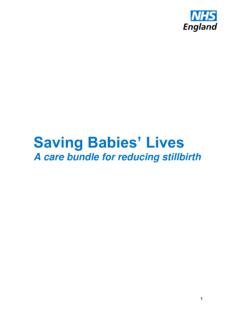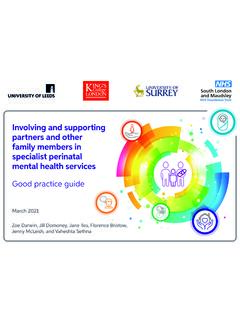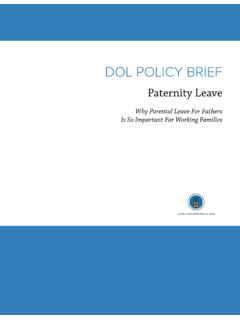Transcription of Expanded Program on Immunisation (EPI)
1 November 8, 2004 Expanded Program on Immunisation (EPI) Infant mortality and under five mortality rates in Ethiopia are among the highest in the world. Diarrhoeal diseases, vaccine preventable diseases (VPDs) and malnutrition are responsible for a majority of childhood deaths in Ethiopia. The Expanded Program on Immunisation (EPI) started in Ethiopia in 1980 with the intention of increasing the Immunisation coverage by 10% annually and reach 100% coverage in 1990. At this point, the Immunisation coverage figures vary largely between regions, from more than 80% DPT3 coverage in Tigray to less than 5% in Somali and Afar regions, resulting in a national DPT3 coverage of about 50% (DPT3 = 3 doses of diptheria, pertussis and tetanus). The long-term goal of the Ministry of Health EPI Strategy is to achieve 90% DPT3 coverage in all regions. Ethiopia is a very diverse country, with a need for development of specific strategies for reaching each area.
2 By the implementation of new approaches called Reaching Every District (RED) and Sustainable Out-reach Services (SOS), the present target is to increase the coverage in certain priority areas by 10% and in others by 5%, giving a total national Immunisation increase of 6% in a year. The objective set in 1980 was not met because of factors such as poor health infrastructure, low number of trained manpower, high turn over of staff and lack of donor funding. The same factors still affect the Program today. The EPI Program is run by the Ministry of Health (MoH) in close cooperation with WHO, UNICEF and other partners and implemented in each region by the Regional Health Bureaus. WHO provides technical assistance to the Ministry of Health and assists in planning, resource mobilisation and social mobilisation. The six vaccine preventable diseases included in the EPI Program in Ethiopia are measles, diphteria, pertussis, tetanus, polio and tuberculosis.
3 Ethiopia has long term plans to introduce new and under-used vaccines, such as hepatitis B (HepB) and hemophilus influenzae type b (Hib). All vaccines are provided for free. ROUTINE Immunisation SUPPLEMENTARY Immunisation ACTIVITIES POLIO ERADICATION INITIATIVE EPI LOGISTICS INJECTION SAFETY 1 November 8, 2004 Routine Immunisation Routine Immunisation is the basis of the EPI activities. On a regular basis vaccines for measles, diphteria, pertussis, tetanus, polio and tuberculosis, are provided in health facilities all over the country. Vaccinations are given in static, out-reach and mobile health facilities. The Immunisation schedule including the above vaccines stretches over the child s first year and tetanus vaccination is given to women of childbearing age. The routine Immunisation coverage in Ethiopia has not reached the targeted figures and planned objectives.
4 Sustainable improvements in the service delivery are needed, in order to protect the Ethiopian children from unnecessary suffering and death. According to the most recent EPI review, conducted in 2001, constraints of the Program are lack of supervision, high drop-out rates, inadequate number of trained health workers and inadequate supplies like cold chain equipment. DPT3 coverage (link to map) EPI schedule (link) [The routine Immunisation schedule in Ethiopia comprises six vaccine preventable diseases, namely measles, diphteria, pertussis, tetanus, polio and tuberculosis. The vaccines are provided free of charge to all eligibles. Before the age of one year, the routine Immunisation schedule should be completed by all children. Women of childbearing age are given tetanus toxoid vaccine to protect their unborn babies from tetanus. The mothers and their future babies obtain full protection after completing the TT schedule.]
5 Vaccine Diseases Age BCG Tuberculosis At birth DPT Diphteria, Pertussis, Tetanus6, 10, 14 weeks OPV Polio At birth, 6, 10, 14 weeksMeasles Measles 9 months Table 1. Routine Immunisation schedule. Dose Time for administration Duration of protection TT1 At first contact No protection TT2 4 weeks after TT1 Three years TT3 At least 6 months after TT2 Five years TT4 At least one year TT3 Ten years TT5 At least one year after TT4 For thirty years (throughout a woman s reproductive life Table 2. Schedule for Tetanus Toxoid administration.] Training (asked for info from Fred and will also collect from SocMob) Inter-Agency Coordinating Committee (link) [There is a felt need by government and partners to co-ordinate technical and material inputs to the Immunisation Program . In light of current and future support, increased technical co-ordination would ensure efficient use and greater impact of technical, material and financial resources.)
6 To this effect a National Inter-Agency Co-ordinating Committee (ICC) was established in order to serve as an advisory body to the Ministry of Health (MOH) through the Family Health Department and Disease Control Departments with the following objectives: To provide technical support, and resource identification and mobilisation that is essential for Program implementation. 2 November 8, 2004 To participate in the planning, follow-up, management, monitoring and evaluation mechanisms of the EPI-Plus Program and advise on improvement. There is also a strong need of coordination of efforts at regional level. Two Regional Inter-Agency Co-ordinating Committees have been established to date and the plan is to expand the initiative to other regions. National ICC Regional ICC established in the Somali Region (link) [Enthusiasm and strong commitment characterised the establishment of the first Regional Inter-Agency Coodinating Committee (ICC) in Ethiopia.]
7 In August, a Regional ICC was established in the Somali Region with the goal to make rapid improvement in routine EPI coverage and to increase the cooperation between partners and allies in the region. In order to address EPI issues regionally in a successful and sustainable way, the MOH has suggested that Regional ICCs should be established throughout the country. The poor routine EPI coverage in the Somali region in combination with a vast presence of active UN agencies and NGOs were the major factors for the choice of region, in which the first Regional ICC in Ethiopia be established. The expectations on the Somali Regional ICC are high and the committee will serve as an example for the establishment of ICCs in other regions. The need for more extensive coordination of efforts in the Somali region is clear, according to the Regional ICC members, who expressed their appreciation for the initiative taken towards the formation of the committee.
8 The Somali Regional ICC progress and impact will be evaluated in February 2004 together with the National ICC. The Somali Regional ICC has representatives from the Regional Health Bureau, Save the Children-USA, Medecins Sans Frontieres-Belgium, Ethiopian Red Cross, Save the Children-UK, Mother and Child Development Organisation, UNICEF and WHO. The newly assigned members of the Regional ICC were ceremonially recognised at the launching ceremony of the Somali SNIDs in the Somali Regional State Congress Hall, Jijiga. The committee members were dressed in colourful aprons by the acting Somali Regional State President, Ato Omar Hadji Ibrahim. The establishment of the Somali Regional ICC is a landmark in the history of Ethiopian EPI. The Somali Regional ICC has full support both regionally and centrally, and the hopes and expectations for rapid improvements in routine EPI coverage are high.
9 Following the establishment of Somali Regional ICC and TAG recommendations other regions are expected to establish their respective Regional ICC very soon.] Southern Nations] Proclamation on EPI by EOTC (link) [The Federal Ministry of Health, WHO and UNICEF organised a high-level advocacy meeting with the Ethiopian Orthodox Tewahido Church (EOTC) on October 17, 2003 in Addis Ababa. At the meeting, His Holiness Abuna Paulos, Patriarch of Ethiopia, Archbishop of Axum and Ichege of the See of St Tekle Haimanot declared a proclamation on EPI in the presence of 550 bishops, archbishops, church leaders, representatives of the Ministry of Health, WHO, UNICEF and Rotary International. The purpose of the proclamation is to make Immunisation he faithfuls child upbringing culture. At baptism, the caretaker will be asked about the Immunisation status of the child and encouraged to complete the vaccination schedule within the child s first year.
10 In the proclamation, EOTC reiterated its support to the Expanded Program on Immunisation (EPI) and called upon every church leader and clergy to implement it at grass root level by informing, through 3 November 8, 2004 different forums, parents and caretakers to have their children immunised against the six childhood killer diseases.] The Global Alliance for Vaccines and Immunization (GAVI) and the Vaccine Fund The Global Alliance for Vaccines and Immunization is an alliance between the private and public sector committed to one goal: saving children's lives and people's health through the widespread use of vaccines. GAVI emerged in 1999 in response to stagnating immunization rates and widening global disparities in access to vaccines. International organizations, governments, the vaccine industry, research institutions, and major philanthropists collectively serve the shared GAVI objectives: expanding the reach of immunization services, introducing priority new vaccines, and establishing tools and systems to promote sustainable financing in developing countries.
















